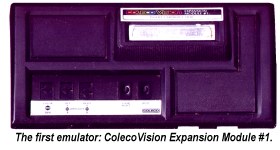 Not far into the early 80’s home video game boom, Coleco – the shortened name of the Connecticut Leather Company, which had gotten into the toy and game business with such products as air hockey tables and minor sporting equipment – was already a player, having snagged some of the biggest arcade game licenses for translation into tabletop games with colorful arcade marquees and cabinet art (miniaturized, of course) and glowing LED screens. But Coleco also seized a golden opportunity by creating the high-end ColecoVision system, probably the most advanced home video game platform available through 1983, and continuing to license popular games from Nintendo and Sega – neither of which, at the time, had created their own home video game systems (almost unthinkable now, isn’t it?).
Not far into the early 80’s home video game boom, Coleco – the shortened name of the Connecticut Leather Company, which had gotten into the toy and game business with such products as air hockey tables and minor sporting equipment – was already a player, having snagged some of the biggest arcade game licenses for translation into tabletop games with colorful arcade marquees and cabinet art (miniaturized, of course) and glowing LED screens. But Coleco also seized a golden opportunity by creating the high-end ColecoVision system, probably the most advanced home video game platform available through 1983, and continuing to license popular games from Nintendo and Sega – neither of which, at the time, had created their own home video game systems (almost unthinkable now, isn’t it?).
 Coleco did things right. Where the Atari 5200 offered no compensation to consumers that – hopefully – would step up from the Atari 2600, one of the earliest ColecoVision peripherals was an adapter that would allow Atari 2600 games to be played on this new system, making Coleco a shoe-in for 2600 owners seeking an upgrade. ColecoVision also appeared just in time to take advantage of another crowd of Atari 2600 users – those who were disgruntled with some of the
Coleco did things right. Where the Atari 5200 offered no compensation to consumers that – hopefully – would step up from the Atari 2600, one of the earliest ColecoVision peripherals was an adapter that would allow Atari 2600 games to be played on this new system, making Coleco a shoe-in for 2600 owners seeking an upgrade. ColecoVision also appeared just in time to take advantage of another crowd of Atari 2600 users – those who were disgruntled with some of the  more pathetic Atari 2600 cartridges on the market (namely Pac-Man). With these two factors working for it, ColecoVision gained a much wider audience than Atari’s 5200.
more pathetic Atari 2600 cartridges on the market (namely Pac-Man). With these two factors working for it, ColecoVision gained a much wider audience than Atari’s 5200.
Though later attempts to add to the ColecoVision legacy capsized – namely the ColecoVision-compatible ADAM home computer – and though Coleco itself eventually went out of business, this is one of the more fondly remembered home video game systems.
[jwcatpostlist orderby=title order=asc includecats=256]
